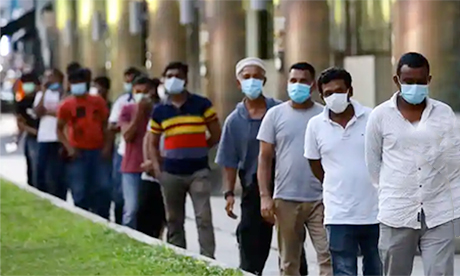Singapore’s government is often praised, domestically and internationally, for its planning and foresight — and, in the past few months, particularly for its response to the coronavirus pandemic.
But recent developments have demonstrated that you can’t have the foresight for things you refuse to see.
A sharp increase in COVID-19 cases among the country’s migrant worker population has now forced the government to take drastic measures.
On Thursday, Singapore saw its highest number of new cases thus far: 728, the vast majority of which were among migrant workers.
Nine dormitories, housing more than 50,000 men, mostly from Bangladesh, India and China, have been declared “isolation areas.”
On Tuesday, the government put all dormitories effectively on lockdown, meaning that about 300,000 workers now have restrictions on their movements within their complexes.
The government appears to have been blindsided by this turn of events.
“Unfortunately, we do not have the luxury of the benefit of hindsight,” Minister for National Development Lawrence Wong said in response to a question at a news conference on April 9. Wong is also the co-chair of a task force put together to lead Singapore’s COVID-19 response.
He added: “The virus is moving so quickly.”
“If I’d known, I would have done things differently. But no one can tell the next step.”
While one can appreciate the number of considerations that the task force has to grapple with, an outbreak of the coronavirus among migrant workers should not have come as such a shock.
The country has nearly a million work permit holders, usually referring to low-wage workers such as domestic workers or manual labourers.
Though domestic workers are required to live with their employers, those who work at construction sites, shipyards, petrochemical refineries, or even as cleaners in neighbourhood estates, live in dormitories, often with about 12 to 20 people in a room.
One of the earlier clusters of COVID-19 was at a construction site.
Migrant labour rights groups have been warning for years that these cramped, crowded conditions were a recipe for disaster.
Transient Workers Count Too (TWC2) and the local media reported an outbreak of chickenpox in 2008.
The same organization pointed out in 2016 that migrant workers were in need of better housing to protect them from the spread of dengue and Zika.
This March, before the outbreak of COVID-19 among migrant workers really hit home, TWC2’s president wrote that the “risk of a new cluster among this group remains undeniable.”
There is no way the government did not know of the conditions in which migrant workers live and the risks that they would face during a global pandemic.
The reality that COVID-19 so harshly reveals is that there has long been two Singapores: one for citizens, long-term residents and expatriates, and one for the low-wage migrant workers who provide the back-breaking labour upon which Singapore gleams.
While immigrants on work visas for white-collar jobs have rights to family reunification and paths to eventual long-term residency and citizenship, low-wage work permit holders have no such options.
They aren’t even allowed to marry Singaporeans or permanent residents in Singapore without first seeking permission from the government.
This logic has even extended into virus containment measures.
At the April 9 press conference, Wong said that it was “important to realize and recognize that we are dealing with two separate infections” — one rising among migrant workers and a more stable situation among the rest of the population.
A later update, shared by the minister on Facebook, separated migrant worker cases from imported and community cases.
A separate task force has been convened specifically to look at migrant worker dormitories, with the military and police force roped in. Continue reading
